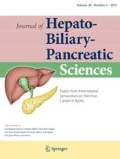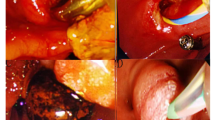Abstract
Background
An accepted treatment strategy for cholelithiasis with secondary choledocholithiasis is the laparoscopic cholecystectomy (LC) following endoscopic retrograde cholangiopancreaticography (ERCP). Although early cholecystectomy is advised, there is no consensus about the time interval between LC and ERCP. The aim of this study is to evaluate the effects of the time interval between ERCP and ERCP on operation outcomes.
Methods
Patients with cholelithiasis and a risk of choledocholithiasis underwent ERCP. Patients were grouped as those operated on between 24 and 72 h after ERCP (group 1) and those operated on more than 72 h after ERCP (group 2). Patients’ age, gender, body mass index, American Society of Anesthesiologists Physical Status, abdominal ultrasonography findings, white blood cell count, total serum bilirubin, ALP, amylase, ALT, AST, GGT levels, ERCP findings, time interval between ERCP and LC, conversion rate, median postoperative hospital stay, median operation time, intraoperative complication and postoperative complication rates were collected.
Results
There was no significant difference between the demographics of the patients in both groups. The median operation time, median postoperative hospital stay and conversion rate in group 2 were significantly higher than those of group 1. More postoperative complications were seen in group 2.
Conclusion
Early cholecystectomy after ERCP, within 72 h, has better outcomes, probably due to the inflammatory processes.
Similar content being viewed by others
References
Sarli L, Iusco DR, Roncoroni L. Preoperative endoscopic sphincterotomy and laparoscopic cholecystectomy for the management of cholecystocholedocholithiasis: 10-year experience. World J Surg. 2003;27:180–6.
Lakatos L, Mester G, Reti G, Nagy A, Lakatos PL. Selection criteria for preoperative endoscopic retrograde cholangiopancreatography before laparoscopic cholecystectomy and endoscopic treatment of bile duct stones: results of a retrospective, single center study between 1996–2002. World J Gastroenterol. 2004;10:3495–9.
Ko CW, Lee SP. Epidemiology and natural history of common bile duct stones and prediction of disease. The NIH State-of-the Science Conference: ERCP for diagnosis and therapy. Gastrointest Endosc. 2002;56:165–9.
Kim KH, Kim W, Lee HI, Sung CK. Prediction of common bile duct stones: its validation in laparoscopic cholecystectomy. Hepatogastroenterology. 1997;44:1574–9.
Fink AS. Current dilemmas in management of common bile duct stones. Surg Endosc. 1993;7:285.
Geron N, Reshef R, Shiller M. The role of endoscopic retrograde cholangiopancreatography in the laparoscopic era. Surg Endosc. 1999;13:452–6.
Cushieri A, Lezoche E, Morino M, Croce E, Lacy A, Toouli J, et al. Multicenter prospective randomized trial comparing two-stage vs single-stage management of patients with gallstone disease and ductal calculi. Surg Endosc. 1999;13:952–7.
Rhodes M, Susman L, Cohen L, Lewis MP. Randomised trial of laparoscopic exploration of common bile duct versus postoperative endoscopic retrograde cholangiography for common bile duct stones. Lancet. 1998;351:159–61.
European Association for Endoscopic Surgery Committee. Diagnosis and treatment of common bile duct stones. Surg Endosc. 1998;12:856–64.
Taylor EW, Rajgopal U, Festekjian J. The efficacy of preoperative endoscopic retrograde cholangiopancreatography in the detection and cleearence of choledocholithiasis. J Soc Laparosc Surg. 2000;4:109–16.
Yamashita Y, Takada T, Kawarada Y, Nimura Y, Hirota M, Miura F, et al. Surgical treatment of patients with acute cholecystitis: Tokyo guidelines. J Hepatobiliary Pancreat Surg. 2007;14:91–7.
Förster S, Klar E. Common bile duct stones. Diagnostic and therapeutic management (in German with English abstract). Chirurg. 2008;79:881–9.
Sarli L, Pietra N, Franze A, Colla G, Costi R, Gobbi S, et al. Routine intravenous cholangiography, selective ERCP, and endoscopic treatment of bile duct stones before laparoscopic cholecystectomy. Gastrointest Endosc. 1999;50:200–8.
Barkun AN, Barkun JS, Fried GM, Ghitulescu G, Steinmetz O, Pham C, et al. Useful predictors of bile duct stones in patients undergoing laparoscopic cholecystectomy. Ann Surg. 1994;220:32–9.
Onken JE, Brazer SR, Eisen GM, Williams DM, et al. Predicting the presence of choledocholithiasis in patients with symptomatic cholelithiasis. Am J Gastreoenterol. 1996;91:762–7.
Barr LL, Frame BC, Coulanjon A. Proposed criteria for preoperative endoscopic retrograte cholangiography in candidates for laparoscopic cholecystectomy. Surg Endosc. 1999;13:778–81.
Hintze RE, Adler A, Veltzke W, Abou-Rebyeh H, Hammerstingl R, Vogl T, et al. Clinical significance of magnetic resonance cholangiopancreatography (MRCP) compared to endoscopic retrograde cholangiopancreatography (ERCP). Endoscopy. 1997;29:182–7.
Sharma SK, Larson KA, Adler Z, Goldfarb MA. Role of cholangiopancreatography in the management of suspected choledocholithiasis. Surg Endosc. 2003;17:868–71.
Eisen GM, Dominitz JA, Faigel DO, Goldstein JL, Kalloo AN, Petersen BT, et al. Standards of practice committee. An annotated algorithm for the evaluation of choledocholithiasis. Gastrointest Endosc. 2001;53:864–6.
Romano F, Franciosi C, Caprotti R, De Fina S, Lomazzi A, Colombo G, et al. Preoperative selective endoscopic retrograde cholangiopancreatography and laparoscopic cholecystectomy without cholangiography. Surg Laparosc Endosc Percutan Tech. 2002;12:408–11.
National Institutes of Health. Consensus development conference statement on gallstones and laparoscopic cholecystectomy. Am J Surg. 1993;165:390–8.
Bergamaschi R, Tuech JJ, Braconier L, Walsøe HK, Mårvik R, Boyet J, et al. Selective endoscopic retrograde cholangiography prior to laparoscopic cholecystectomy for gallstones. Am J Surg. 1999;178:46–9.
Binmoeller KF, Schafer TW. Endoscopic management of bile duct stones. J Clin Gastroenterol. 2001;32(2):106–18.
Costi R, DiMauro D, Mazzeo A, Boselli AS, Contini S, Violi V, et al. Routine laparoscopic cholecystectomy after endoscopic sphincterotomy for choledocholithiasis in octogenarians: is it worth the risk? Surg Endosc. 2007;21(1):41–7.
Boerma D, Rauws EA, Keulemans YC, Janssen IM, Bolwerk CJ, Timmer R, et al. Wait-and-see policy or laparoscopic cholecystectomy after endoscopic sphincterotomy for bile-duct stones: a randomised trial. Lancet. 2002;360:761–5.
Lau JY, Leow CK, Fung TM, Suen BY, Yu LM, Lai PB, et al. Cholecystectomy or gallbladder in situ after endoscopic sphincterotomy and bile duct stone removal in Chinese patients. Gastroenterology. 2006;130:96–103.
Hazan D, Geron N, Golijanin D, Reissman P, Shiloni E. Laparoscopic cholecystectomy in octogenarians. Surg Endosc. 2003;17:773–6.
Kilciler G, Musabak U, Bagci S, Yesilova Z, Tuzun A, Uygun A, et al. Do the changes in the serum levels of IL-2, IL-4, TNFα, and IL-6 reflect the inflammatory activity in the patients with post-ERCP pancreatitis? Clin Dev Immunol. 2008;2008:481560.
Chen CC, Wang SS, Lu RH, Lu CC, Chang FY, Lee SD. Early changes of serum proinflammatory and anti-inflammatory cytokines after endoscopic retrograde cholangiopancreatography. Pancreas. 2003;26:375–80.
Author information
Authors and Affiliations
Corresponding author
About this article
Cite this article
Salman, B., Yılmaz, U., Kerem, M. et al. The timing of laparoscopic cholecystectomy after endoscopic retrograde cholangiopancreaticography in cholelithiasis coexisting with choledocholithiasis. J Hepatobiliary Pancreat Surg 16, 832–836 (2009). https://doi.org/10.1007/s00534-009-0169-4
Received:
Accepted:
Published:
Issue Date:
DOI: https://doi.org/10.1007/s00534-009-0169-4




